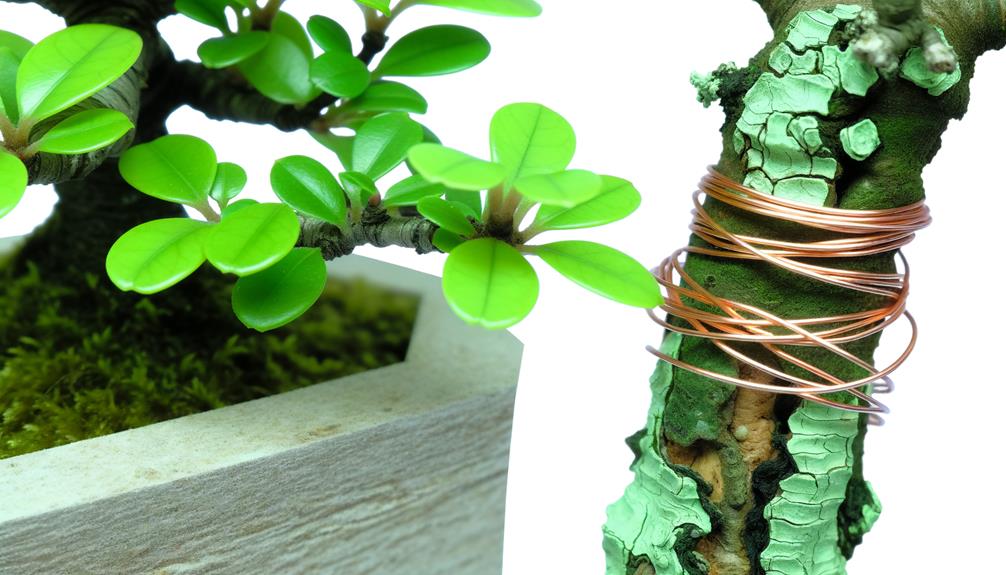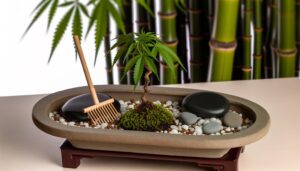Copper Vs Aluminum Bonsai Wire – 7 Key Differences
Choosing between copper and aluminum bonsai wire is crucial for tree training and health. Copper wire offers superior tensile strength and work-hardening properties, making it ideal for shaping robust hardwoods such as pines and junipers.
Aluminum wire, lighter and more flexible, suits beginners and softer wood species like maples and elms. Copper provides long-term structural integrity but poses a higher risk of bark damage.
In contrast, aluminum requires more frequent adjustments but is safer for delicate bark. Wire thickness also plays a crucial role in control and support.
To make an informed decision, consider these technical aspects further.

Key Takeaways
- Copper wire is stronger and more durable but harder to adjust and poses a higher risk to delicate barks.
- Aluminum wire is lighter, more flexible, and safer for sensitive bark, making it ideal for beginners and softer wood species.
- Copper wire requires annealing for better flexibility, providing superior shaping and long-term structural support.
- Aluminum wire is easier to apply and reuse, though it may need more frequent adjustments due to lower tensile strength.
- Wire selection depends on tree species, branch thickness, and desired balance between structural support and ease of application.
Material Composition

Both copper and aluminum bonsai wires are specifically chosen for their distinct material compositions, which directly impact their malleability, strength, and suitability for different bonsai training techniques.
Copper, often preferred for its superior tensile strength and work-hardening properties, can be annealed to increase its initial malleability, allowing for precise adjustments. Over time, as the copper hardens, it maintains the desired shape of the bonsai branches more effectively.
Conversely, aluminum wire is characterized by its lighter weight and inherent flexibility, making it suitable for beginners and for training younger, more delicate branches. Its ease of manipulation without the need for annealing simplifies the wiring process, although it may require more frequent adjustments compared to copper.
Both materials offer unique advantages depending on specific horticultural needs.
Strength and Durability
When evaluating the strength and durability of copper versus aluminum bonsai wire, it is essential to assess their tensile strength and longevity in use.
Copper wire typically exhibits superior tensile strength, allowing for more secure and lasting shaping of bonsai branches.
Conversely, aluminum wire, while easier to manipulate, may necessitate more frequent adjustments due to its relatively lower tensile strength and potential for quicker wear.
Tensile Strength Comparison
Copper bonsai wire demonstrates exceptional tensile strength and durability in contrast to aluminum wire, making it a preferred choice for professional bonsai artists seeking long-term structural integrity. The tensile strength of copper allows for finer control and better grip on branches, minimizing the need for frequent adjustments. This strength ensures that the wire maintains its shape under stress without breaking, providing dependable support.
| Property | Copper Wire | Aluminum Wire |
|---|---|---|
| Tensile Strength | Superior | Inferior |
| Durability | Outstanding | Good |
| Flexibility | Moderate | High |
The superior tensile strength of copper translates into enhanced durability, crucial for intricate bonsai work. While aluminum is more flexible, it lacks the same level of structural reliability, making copper the ideal choice for sustained shaping and training of bonsai trees.
Longevity in Use
The longevity of bonsai wire regarding strength and durability is a critical factor for maintaining the desired shape and health of bonsai trees over extended periods. Copper wire, known for its superior tensile strength, offers exceptional durability, allowing it to hold branches firmly in place for longer durations without degrading. This quality makes copper ideal for older, more rigid trees.
Conversely, aluminum wire, while easier to manipulate, tends to lose its rigidity over time, necessitating more frequent adjustments. Aluminum's softness can be advantageous for younger trees with more pliable branches but may require replacement sooner. Ultimately, the choice between copper and aluminum hinges on the specific needs of the bonsai, balancing long-term stability with ease of use.
Flexibility and Ease of Use

Understanding the flexibility and ease of use of bonsai wire is essential for effective tree shaping and maintenance.
Copper wire, known for its superior malleability, allows for precise and sustained shaping. Its ability to hold its form makes it particularly beneficial for more intricate bends and adjustments.
Conversely, aluminum wire offers greater ease of use, particularly for beginners. Its lighter weight and softer texture make it easier to apply and remove without causing damage to the tree.
While aluminum may not hold its shape as long as copper, its reusability and less rigorous application process provide a balanced alternative.
Both materials have distinct advantages, contingent on the specific requirements and skill level of the bonsai practitioner.
Application Techniques
Mastering the application techniques for bonsai wire involves understanding the specific methods required for both copper and aluminum to ensure ideal shaping and tree health. Copper wire, known for its strength, requires annealing before use to improve its flexibility. Once applied, it hardens, maintaining the desired shape more effectively. Aluminum wire, being more flexible, is easier to manipulate and is best for beginners or delicate branches. The following table outlines the key differences in application:
| Aspect | Copper Wire | Aluminum Wire |
|---|---|---|
| Flexibility | Requires annealing | Naturally flexible |
| Ease of Application | More challenging | Easier for beginners |
| Strength | Superior | Moderate |
| Ideal Use | Stronger branches | Delicate branches |
Understanding these nuances is essential for best bonsai care.
Wire Thickness Options

Selecting the appropriate wire thickness for bonsai wiring is crucial for achieving optimal control and support without harming the tree. Copper and aluminum wires come in various thicknesses, typically ranging from 1mm to 6mm.
Thicker wires provide superior structural support but may be more difficult to maneuver, especially for intricate designs. Conversely, thinner wires are easier to manage but offer less support and may require doubling for effectiveness. Copper wire, being sturdier, necessitates a finer gauge compared to aluminum wire to achieve the same level of control.
Proper selection involves evaluating branch thickness and flexibility, ensuring the wire can guide growth without cutting into the bark, thereby preserving the tree's health and aesthetics.
Cost Comparison
The cost disparity between copper and aluminum bonsai wire is a significant consideration for enthusiasts and professionals, influenced by factors such as raw material prices, manufacturing processes, and market demand. Copper wire, known for its superior strength and malleability, generally commands a higher price due to the complexities of extraction and processing. Conversely, aluminum wire, while more affordable, offers less tensile strength but is favored for its ease of use and lower cost. Below is a comparative table illustrating the average costs:
| Attribute | Copper Wire | Aluminum Wire |
|---|---|---|
| Raw Material Cost | Higher | Lower |
| Manufacturing | Complex | Simpler |
| Market Price | Premium | Economical |
| Durability | High | Moderate |
| Availability | Limited | Plentiful |
This cost differential impacts purchasing decisions, especially for large-scale projects.
Suitability for Tree Species

When selecting bonsai wire, compatibility with various tree species is paramount, as different trees have distinct requirements for wire strength and bark sensitivity.
Copper wire, known for its superior strength, is often preferred for species with thicker branches, whereas aluminum wire is more suitable for delicate or thin-barked trees due to its gentler application.
Understanding these nuances guarantees that the appropriate wire is chosen to support the tree's health and aesthetic development.
Tree Type Compatibility
Understanding the compatibility of copper and aluminum bonsai wire with various tree species is important for achieving best shaping and growth control.
Copper wire is generally preferred for coniferous species, such as pines and junipers, due to its superior holding strength and ability to maintain shape longer. Its rigidity ensures stable positioning, which is essential for these harder wood types.
Conversely, aluminum wire is more suited for deciduous species, including maples and elms, where greater flexibility and ease of adjustment are required. Aluminum's malleability reduces the risk of bark damage, making it ideal for these softer wood trees.
Selecting the appropriate wire type based on species ensures ideal application, minimizes stress on the tree, and promotes healthy development.
Wire Strength Requirements
Evaluating wire strength requirements is necessary for guaranteeing the effective shaping and health of bonsai across various species. Copper wire, known for its superior tensile strength, is particularly suitable for robust, hardwood species such as pines and junipers. Its ability to hold shape firmly makes it ideal for thick branches that require substantial manipulation.
Conversely, aluminum wire, while less rigid, offers sufficient strength for more delicate species like maples and elms. Its malleability ensures easier adjustments without exerting excessive pressure on softer wood. Selecting the appropriate wire strength is important; inadequate support can lead to suboptimal shaping, while excessive rigidity may damage the tree.
Therefore, understanding the specific requirements of each bonsai species is essential for optimal growth and aesthetics.
Bark Sensitivity Concerns
Bark sensitivity in bonsai species requires careful consideration when choosing between copper and aluminum wire to avoid causing undue stress or damage to the tree.
Copper wire, while offering superior holding strength, is harder and can potentially cause more harm to delicate bark, especially in younger or more sensitive species. Conversely, aluminum wire is softer and more flexible, reducing the risk of bark injury but might require more frequent adjustments due to its lower strength.
Selecting the appropriate wire type based on the specific tree species' bark sensitivity is essential for maintaining tree health and aesthetics.
- Copper Wire: Higher strength, riskier for sensitive bark.
- Aluminum Wire: Softer, safer for delicate bark.
- Tree Age: Younger trees often prefer aluminum.
- Species Sensitivity: Important for wire choice.
- Adjustment Frequency: Aluminum may need more frequent changes.
Long-Term Effects
In the long term, the choice between copper and aluminum bonsai wire greatly impacts the tree's growth patterns, structural integrity, and overall health. Copper wire, known for its strength and ability to hold shape, can lead to more precise styling but poses a higher risk of bark damage if not monitored closely. Aluminum wire, while gentler and easier to manipulate, may require more frequent adjustments due to its tendency to lose tension over time.
| Aspect | Copper Wire | Aluminum Wire |
|---|---|---|
| Strength | High | Moderate |
| Flexibility | Low | High |
| Risk of Bark Damage | High | Low |
| Frequency of Adjustment | Low | High |
Selecting the appropriate wire is essential for achieving desired bonsai aesthetics and ensuring the tree's longevity.
Conclusion
The comparative analysis of copper and aluminum bonsai wire reveals distinct advantages and limitations inherent to each material. Copper offers superior strength and durability, albeit at a higher cost and reduced flexibility.
Aluminum, conversely, provides improved maneuverability and cost-effectiveness, yet may lack the strength required for certain tree species.
Ultimately, the careful selection of wire material, informed by specific horticultural needs and economic considerations, guarantees the delicate balance between art and science in the cultivation of bonsai trees.






